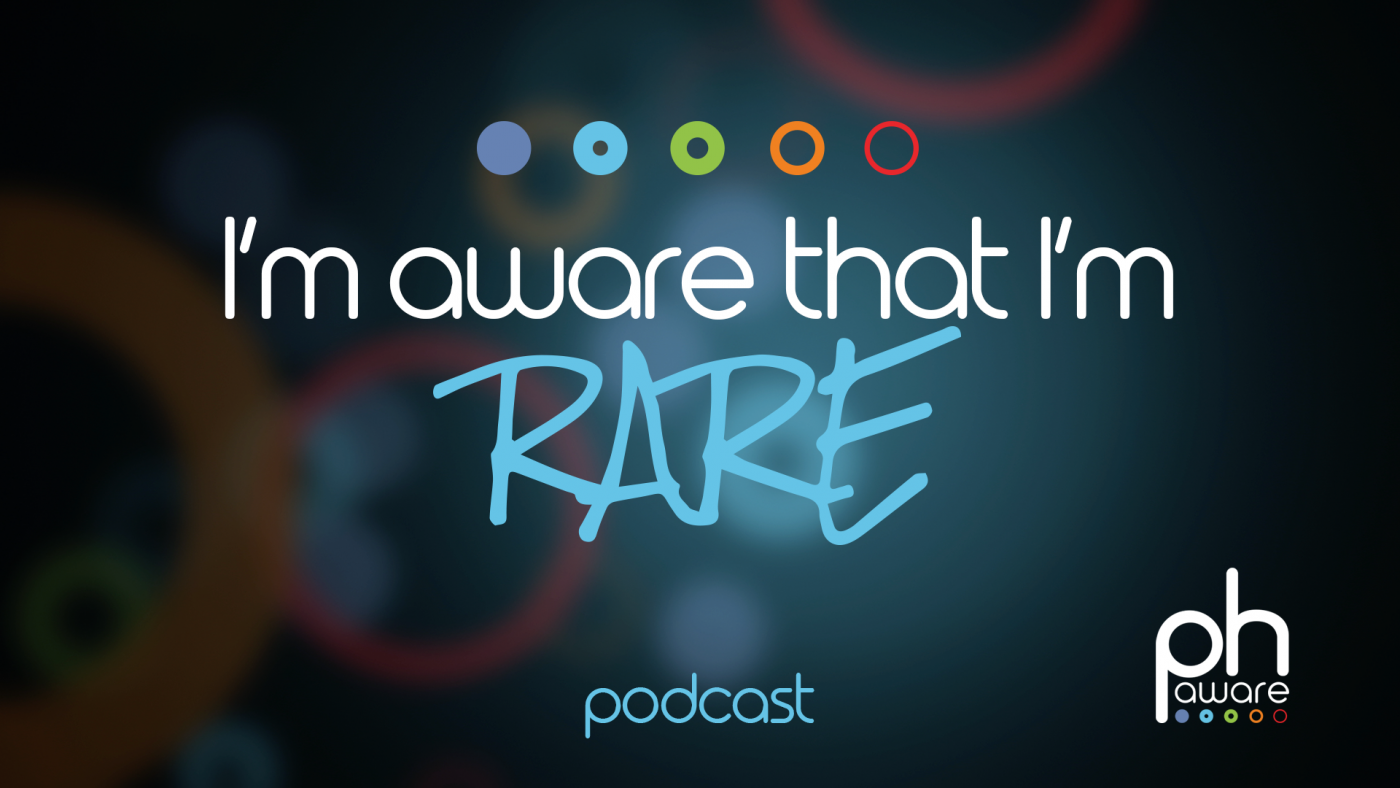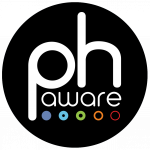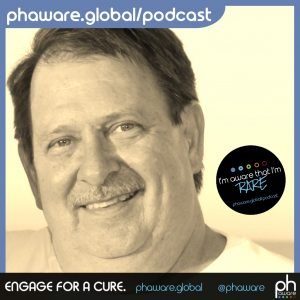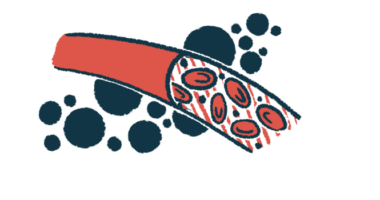Phaware Podcast: Denneys Niemandt

This podcast series, created and produced by phaware, is being offered as a regular guest feature on Pulmonary Hypertension News to bring the voices and life experiences of PH patients, family members, caregivers, healthcare specialists, and others to our readers. You may listen to the podcast directly, or read it via the transcript that runs below.
I’m Aware That I’m Rare: Denneys Niemandt
The phaware™ interview
Denneys Niemandt is a pulmonary hypertension patient and PH global leader from South Africa. Denneys was instrumental in establishing The Pulmonary Hypertension Association of South Africa. At the time of his diagnosis, he was only one of 10 known cases of PH in South Africa. He discusses why research and awareness are of the utmost importance in his country.
Hi! My name is Denneys Niemandt, I’m 50 years old, from the beautiful city of Cape Town in South Africa.
My journey with pulmonary hypertension began on a sunny Saturday in September 2006, when my wife Sonia and I went shopping on a Saturday afternoon. In the supermarket, I started feeling out of breath and experiencing  tightness in my chest and pain in my right arm. I then asked my wife twice why they were switching the lights on and off in the supermarket, not realizing that I was actually having a blackout. When I really came together again I found I was sort of almost like lying over the shopping trolley, and not 100% knowing where I was.
tightness in my chest and pain in my right arm. I then asked my wife twice why they were switching the lights on and off in the supermarket, not realizing that I was actually having a blackout. When I really came together again I found I was sort of almost like lying over the shopping trolley, and not 100% knowing where I was.
The lucky part of it is it was right across the N1 City Hospital here in Cape Town, and the doctors … they had performed some tests and my ECG showed no abnormalities. They then told my wife that I actually had a little bit of a heart attack and I needed to see the cardiologist on duty. Fortunately for me, the cardiologist on duty was a Dr. J.P. Smedema. He had experience dealing with PH in his home country in the Netherlands and he was in South Africa starting his own practice here. At that stage, in 2006, PH was not well-known in South Africa, and it was definitely often misdiagnosed.
When he explained to me that PH is a very serious and terminal disease, it felt as if my world fell apart, because at that stage, my daughter was 15 years old and my son was 13, and I thought I will never see them become young, beautiful teenagers. I then told Dr. Smedema that I had been in and out of hospital over the last 15 of 20 years with pleurisy pneumonia and cardiac arrhythmias.
At one point, I went to see a specialist and he even told me it was all in my mind. This specific specialist told me to exercise a bit more, to stop thinking myself sick and to lose some weight. That bothered me quite a bit, because I was quite active at that stage, because my son was doing quite a lot of exercising and he was a junior champion, Western Cape champion in hurdles, and I was practicing and exercising with him. The more I started exercising with him the worse I was starting to feel every time. Then when this happened, when I had the blackout at the supermarket, that’s then when Dr. Smedema diagnosed me with pulmonary hypertension.
The very strange thing about it at that stage, we were not sure … I wasn’t even aware that there’s different stages, or different phases, or different categories of pulmonary hypertension. He then explained to me that at the age of 14, I was diagnosed with hereditary spherocytosis and a splenectomy was performed. Five years after that, I had also had a cholecystectomy. Dr. Smedema wrote an article titled, “Pulmonary arterial hypertension after splenectomy for hereditary spherocytosis,” in the Cardiovascular Journal of South Africa, in which he concluded that my PH was brought on 32 years after my splenectomy. That was quite strange and also mind-boggling. Apparently, what he explained to me is microscopic emboli had formed in my lungs and that was the beginning of my PH. That is how my life started at the age of 47 with PH hanging over my head.
The biggest mistake I made is my wife and I Googled PH and, as you all know, it is only doom and gloom if you read about PH on the internet. Luckily, my wife Sonia worked at the medical faculty of the University of Stellenbosch, and she helped me do proper research about PH and make changes to my lifestyle. At that stage, also I made some contact with pulmonary hypertension leaders in organizations who had the same … if I can say it, dreaded disease.
It’s not always easy for me and it wasn’t easy. The biggest challenge I had is that always I used to be very active, and then all of a sudden I got tired all the time. My son Dennys was 13 years old when I was diagnosed. We used to play golf and ballgames, but I had to explain to him that I could no longer do it anymore, even if I wanted to, which frustrated me quite a lot. I got depressed thinking about my physical limitations and I had a difficult time controlling my emotions. My idea of taking so many medications was also overwhelming.
I started then thinking if I’m one of 10 or one of the first 10 in South Africa, then there must be possibly hundreds and maybe thousands of other patients in South Africa. So, I started together with a few patients that I knew at that time to get together and we formed the Pulmonary Hypertension Association of South Africa. Took us about two years to register it as an official nonprofit organization.
When we managed to do that, things went quite well. We started getting funds and we managed to sort of like kick-start the PH South Africa Organization with a bang. That was in 2008. Subsequently, I was chairman of the organization until about two, two and a half years ago when, unfortunately, they found out that I’ve got colon cancer, stage 3, and they had to operate and do a hemicolectomy, which means that they had to cut away half of my colon, and also they removed 24 glands, of which 12 were cancerous. The first part of the chemo was not very successful. I was either allergic to the chemo, or it was a bit of a high dosage, because I ended up in ICU for about three weeks, where I was not aware what was going around me for almost two of the three weeks.
They then took me off the chemo for three to four months to recover, and the following year, I started with a new program of chemo for six months. I was fortunate in that time, I attended the Saudi Arabia PH Conference in Dubai, and it was a fantastic experience. But it wasn’t all that good with me having chemo in between. When I came back, I had to restart the chemo program, and it took me about six months to really come back to normal.
In that time, I decided to withdraw from the PH Society of South Africa, because as far as I felt, it was a bit unfair for me to be chairman of an organization if I could not fulfill my duties because of my health. I’m still part of the organization in the way of creating awareness, but not in the capacity as a board member or as chairman. Hopefully, things will improve in South Africa, because for the last seven, eight years, we were working hard to achieve that.
In the U.K. and America, I think there’s something like 14 officially registered medications. In South Africa, there’s basically one and at quite a cost, but that is the situation in South Africa. One other specialist in South Africa, Dr. Paul Williams, he at one of our conferences said, “You know, we are a first world country, but we’ve got third world medication and treatments for diseases like pulmonary hypertension.” Yet in the same breath he mentioned, “We can do heart transplants, we can do lung transplants, but we haven’t got the facility or the know-how to develop or to get proper medication for the disease.”
It’s a very sad story in South Africa when it comes to awareness. I’ve had various interviews with the television and broadcasting people in South Africa, some radio stations, and also TV over the last few years. It helped in a way, but [it was] very limited. We also started the Blue Lips awareness campaign, which also helped up to a point. I think if I can compare with, for instance, America and the United Kingdom, we are probably about 20, 25 years behind when it comes to recognizing, treating, and early diagnosis of this disease in South Africa, which is actually a bit of a sad story.
Although South Africa is quite big, if you look at it in comparison to the rest of Africa, I think the biggest problem is doctors, specialists, cardiologists, pulmonologists, all of them are very, very at the beginning stage of the whole process. We’ve got maybe six or seven cardiologists in South Africa and about maybe 10 pulmonologists who started in the last few years, getting more and more involved.
To be honest, I think our registry is our biggest problem, because whenever we apply for either sponsorships or new medications, the first question is, “What is the registry about? What is your registry?” We had a brainstorming session about three years ago with 25 or 30 cardiologists and about 30 pulmonologists, and also again, Dr. Badesch came over from the United States. I can’t remember offhand his name now, but he was a big specialist and very famous from France. He came over, as well, and with Dr. Paul Williams and a few of the people here, they started putting notes together, to put a registry together and also to put the blueprint together, of how things can be managed and how things can be adapted, very similar to the blueprint that was done overseas, which the U.K. use as their sort of like benchmark.
Unfortunately, this whole process takes quite a bit of time, because it’s now almost two, three years later and we still haven’t got a final answer, or final registry to go to people and say, “This is what it’s all about,” because that is very important in the facts and the figures and the things for pulmonary hypertension. Because if you go to government or big institutions, the first thing they ask is, “How many people are involved?” If you say 80 to 100 people in South Africa, they say, “We’ve got empathy with you guys, but TB and AIDS, we’re talking about maybe 50,000, 60,000 people. So, if we allow budget for medication and things to all the people then we have to give preference to the majority.” Obviously, 60,000, 70,000 people get preference over 100 to 120, 100 to 150 people.
Africa itself, which South Africa is a part of, pulmonary hypertension is not a very familiar or well-known disease, but AIDS is one of the biggest factors in Africa itself. Ninety percent of people who have HIV probably would have pulmonary hypertension as well, because there is a direct link or correlation between the two. The irony of it is that although Africa is one of the biggest contributors to HIV sufferers and deaths, and even TB, the link has not been made yet that it can possibly contribute to a high number of pulmonary hypertension patients in Africa, as well.
We’ve got patients that contacted me just north of South Africa, which is Zimbabwe, Botswana, Malawi, Congo. They actually said, “When are we going to get some help with our patients, because we don’t even know anything about it. We haven’t even established what the consequences are beyond our own borders, because we don’t even know what the real situation in South Africa is, never mind about what’s happening just across the border.” In Africa itself, I think it’ll probably be 10 times more pulmonary hypertension patients than in the U.K. and the USA together, [it’s] just that we don’t know about them.
Research and awareness of pulmonary hypertension in South Africa are of the utmost importance, specifically because there’s so little known about pulmonary hypertension in South Africa. It starts off right with general practitioners, specialists, and the general public, and also pharmaceutical companies, government institutions. Everybody in South Africa, if you talk about pulmonary hypertension, they’re thinking you’re talking about high blood pressure with them. They say, “Yeah, we all got high blood pressure, we all got hypertension.” They don’t understand the concept of pulmonary hypertension and that it’s a life-threatening disease, and that it’s a terminal disease, and that it’s affecting anybody, gender, race, age, it doesn’t matter what in South Africa like anywhere else in the world.
That’s why it’s important for us to build up, first of all, a very reliable registry, so that when we approach big pharmaceutical companies, government and even international institutions that can be supplementary to support our cause, because just doing the normal awareness and fundraising projects is working, but it’s not good enough. It’s gotta be something big, it’s gotta be something … a movement all over the world. I think that was very successful with the whole European … PHA Europe, where they’ve got, I think if I’m not mistaken, 30, 40 countries that’s taking part in that and in America itself.
In South Africa, logistically it’s very difficult at the moment, because for instance, I’m staying in Cape Town. We are three, four patients in South Africa, in Cape Town. Then there’s probably 1,500 kilometers farther away Johannesburg or Gauteng. There’s another 10 or 15 patients. Then in Bloemfontein, which is another 600 kilometers away, there’s maybe three patients. In Durban, KwaZulu-Natal, which is again 600 kilometers away, there’s maybe 10 or 15 patients. Then there’s all the little small towns, or whatever, where there are one or two or three patients that we know of. There might be hundreds and thousands that we don’t know of, especially in the rural areas and in the smaller towns and things in South Africa.
For us, it’s of the utmost importance to create awareness. But the creating of awareness should coincide with a specific awareness in the sense of it must hit at the right places high up, like in government, medical practitioners, government institutions, pharmaceutical companies, etc. That, unfortunately, is at the moment not happening in South Africa. I know about 15, 16 patients that have got no medical help, medical funding, they’ve got to pay for these medicines out of their pocket, or they’ve got to go to state hospitals, which are not geared up for pulmonary hypertension patients, because it’s like walking into a brick wall. They don’t understand it, they don’t know about it, and they certainly don’t have the medication for it.
The biggest hope that we’ve got is that we’ve got more people like, … If I can mention, Dr. Smedema, Dr. Paul Williams and Professor Aesop. That’s the people that really started the ball rolling and they understand what the needs and the problems of pulmonary hypertension patients are in South Africa.
For the thing to grow … in all facets – financially, medication, treatment, early diagnosis, which I think is very important, because at the moment that’s one of the biggest factors that’s maybe causing deaths and so on in pulmonary hypertension patients, because of not an early diagnosis.
I would like to see us grow together with maybe even other organizations. I know in Africa there’s not many, I think there’s Israel, and there’s not many associations or maybe pharmaceutical companies that deal a lot with those big organizations to spill over to people like us in South Africa and all other smaller countries where we are not getting at the moment the help and the support that we should get.
My name is Denneys Niemandt from Cape Town in South Africa and I’m aware that I’m rare.
EVERYBODY HAS A STORY. WHAT’S YOURS?
phaware wants to share your pulmonary hypertension story with their engaged global audience. Whether you are a patient, caregiver, or medical professional, they are enlisting PH community members from across the globe. Visit www.phaware.global/podcast to share your story and to be considered for a future episode.And learn more about pulmonary hypertension at www.phaware.global. #phaware #phawarepod
***
Note: Pulmonary Hypertension News is strictly a news and information website about the disease. It does not provide medical advice, diagnosis, or treatment. This content is not intended to be a substitute for professional medical advice, diagnosis, or treatment. Always seek the advice of your physician or other qualified health provider with any questions you may have regarding a medical condition. Never disregard professional medical advice or delay in seeking it because of something you have read on this website. The opinions expressed in this column are not those of Pulmonary Hypertension News or its parent company, BioNews Services, and are intended to spark discussion about issues pertaining to pulmonary hypertension.










Comments